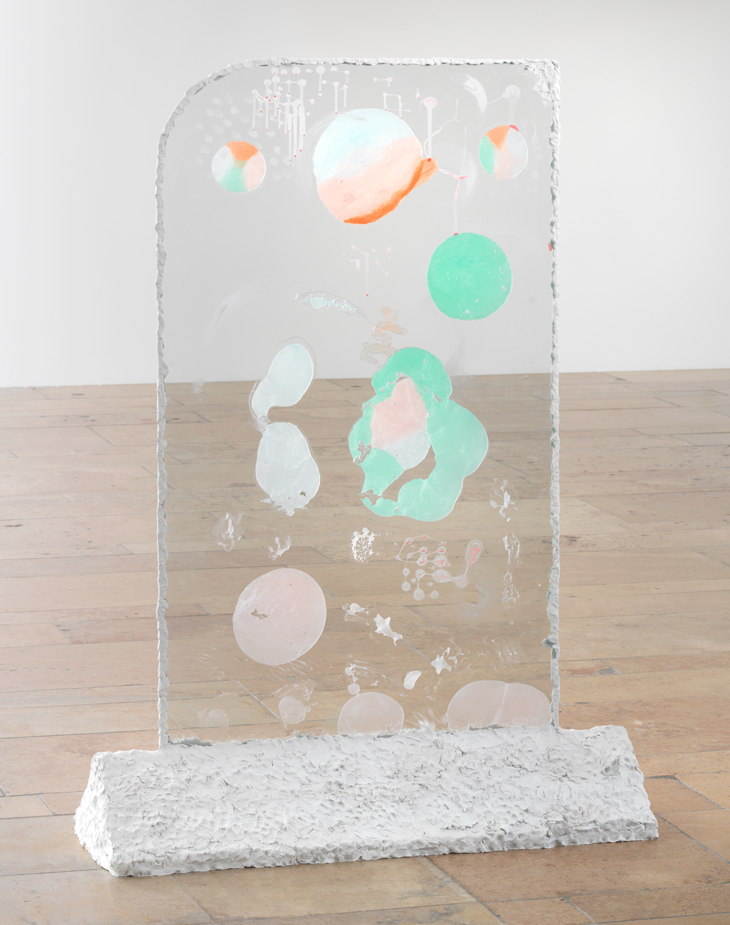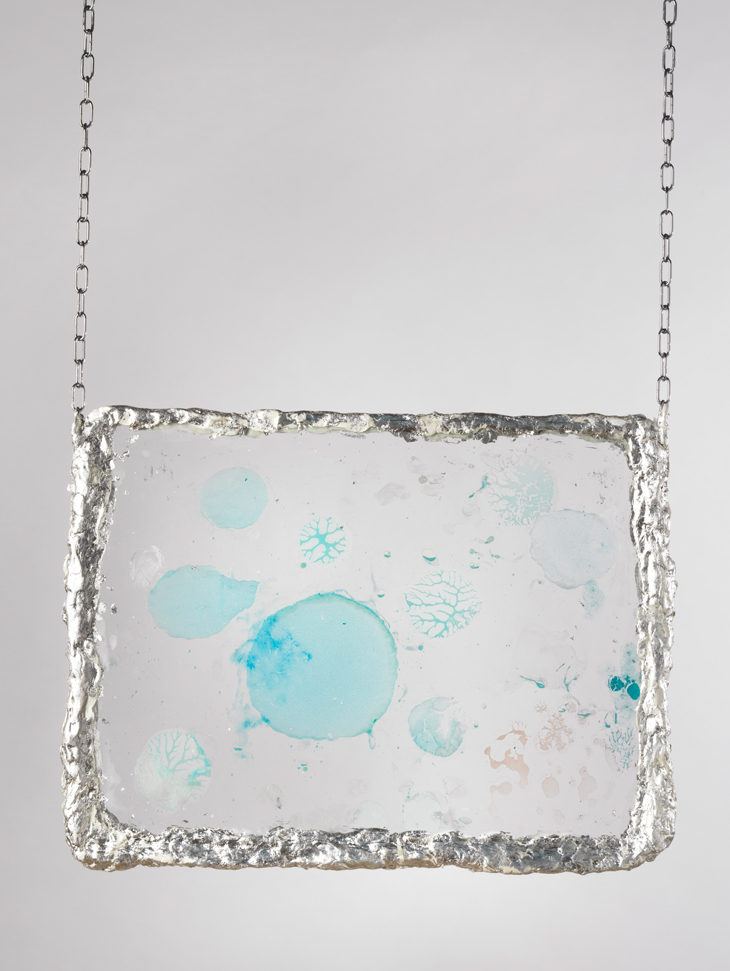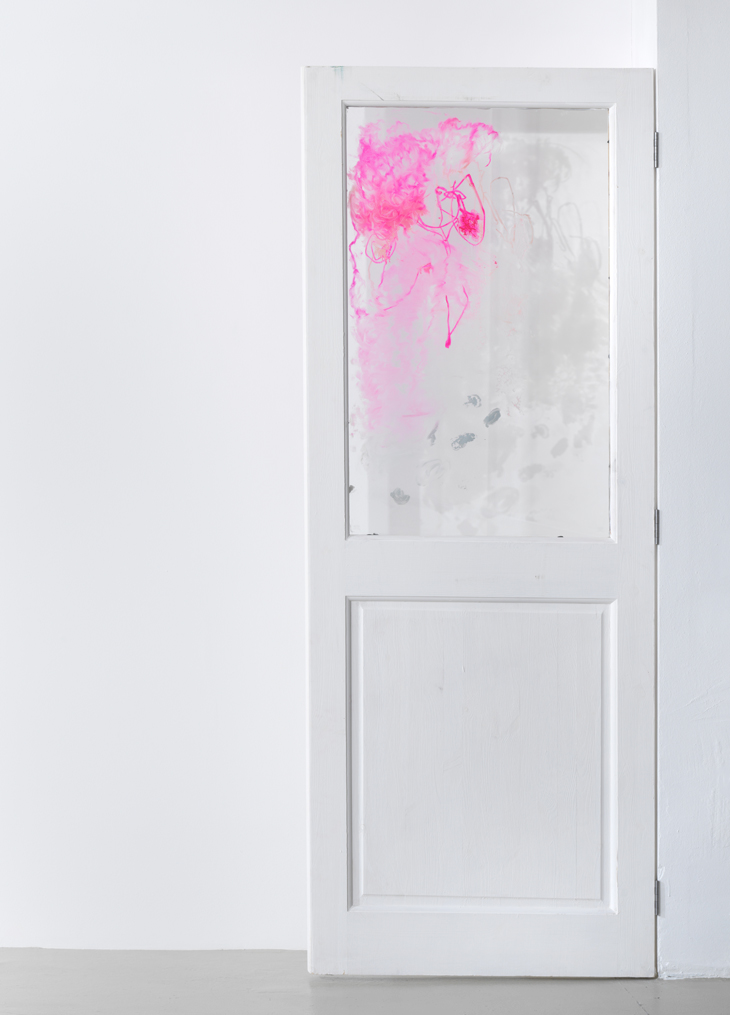At first glance, certain aspects of everyday life are thrown into relief by Karla Black’s exhibition at Capitain Petzel; wet towels left to dry on the radiator; traces of fingerprints on window panes and haphazard marks covering the white walls; toilet paper and cotton wool thrown on the floor. However, in the context of Black’s work, it’s best not to place too much weight on the associations that we might bring into the gallery. The artist has said that the experience of mark-making and the art’s material resonance is the primary factor that defines her practice. Language (including the work’s titles) and meaning are secondary.
With symbolism rendered irrelevant, we must turn instead to the direct experience and material reality of these works, which are markedly fragile, translucent and, to some degree, ephemeral. In terms of categorisation, they reach out towards painting, performance and installation art – offering the hand of friendship to other media, while remaining firmly rooted in sculpture. The works at Capitain Petzel, all made in 2018, spread and overlap through space — smeared pigment extending over the shop-front windows (Bring Jewels), enclosing coloured wool and toilet paper that peppers the floor and connects to seemingly-incidental wall paintings (Structure For Once) — yet the installation itself feels pointedly sparse. Black’s marks in the space are not obvious and you have to move your body and activate your intrigue to spot some of them. Arguably, this subtlety is part of the artist’s project: to playfully search out the direct experience of matter and, as such, reconsider the function and consequences of sculpture in the gallery. Citing the psychoanalytic theory of Melanie Klein, who researched play as a language through which to assess our experience of the world, Black ignites this theoretical framework as we ask what it is that her sculptures actively and physically do.

Paths Properly Told (2018), Karla Black. Photo: Jens Ziehe; courtesy Capitain Petzel, Berlin; © the artist
The exhibition’s most clearly autonomous works are Paths Properly Told and Unlike, glass panels shaped like car windows (there with the associations again), one corner smoothed off, embedded into a floor-based pedestal of fingered clay. Between these glass sheets, Black has played with different pigments; in the latter, tan-coloured foundation dribbles while circles of baby blue, lemon yellow and pale pink rise through the pane, some appearing as amorphous blobs that engulf others. The artist doesn’t differentiate between traditional media such as paint, plaster and clay and more quotidian matter including eye shadow, Vaseline, lipstick, cotton wool and toilet paper – and she rejects any feminising discourse on these materials. After all, whether bought at the art shop or chemist, it is all physical stuff that expresses the world in which we live.

Withhold Favour (2018), Karla Black. Photo: Jens Ziehe; courtesy Capitain Petzel, Berlin; © the artist
These two works are no exception to the artist’s existing oeuvre, continuing her investigation into the formal, aesthetic quality and seamlessness of materials. A notable development, however, is her use here of freestanding (or hanging) glass as a means of suspending gesture in space – previously she used cellophane or clear plastic, which was billowy. Works such as Withhold Favour – glass panels sandwiching blue pigments, framed with the same fingered clay but layered with silver leaf and suspended in mid air using two silver chains hanging from the double-height ceiling – allow light to pass through, illuminating the colours from all angles and layering them with the surrounding tones. The result is the expansion of the work itself, which merges with the rhythmic delineation of similarly-coloured balls of wool (part of Structure For Once) that are visible behind the glass, and an activation of the building’s architecture, which itself provides surfaces of contiguity that add further layers to the work’s materiality.

Rush to Correct (2018), Karla Black. Photo: Jens Ziehe; courtesy Capitain Petzel, Berlin; © the artist
Architectural features are also subsumed into Black’s recent work. Sculptures such as Rush to Correct comprise doors with glass panels attached to the walls using hinges. Shocking pink scribbled lines are delineated in the top-left-hand part of the glass, and then smudged and softened, light passing through to illuminate the smeary patches. Black has previously emphasised her interest in horizontality – being close to the ground and the pre-linguistic mode of how we viewed the world as children. But verticality – looking up – is a factor here, perhaps a direct response to the vast ceiling heights of Capitain Petzel. Site-specificity is a cornerstone of Black’s approach.
While the artist rightly rejects any essentialist attempt to define her work and its materiality as feminine, the pre-linguistic aspect of her sculptures is nonetheless significant in this respect. As analysed in the work of post-Lacanian feminist theorists such as Luce Irigaray, for example, the realm beyond language is a distinctly amorphous, female space, one that exists outside of the symbolic order – fitting when considered in relation to Black’s disregard for symbolism. When it comes to psychoanalytic theory, the unconscious space that the artist acknowledges and works through lends more of a gendered nuance to her production than she might consciously accept.
‘Karla Black’ is at Capitain Petzel, Berlin, until 14 April.














![Masterpiece [Re]discovery 2022. Photo: Ben Fisher Photography, courtesy of Masterpiece London](http://zephr.apollo-magazine.com/wp-content/uploads/2022/07/MPL2022_4263.jpg)
Suzanne Valadon’s shifting gaze